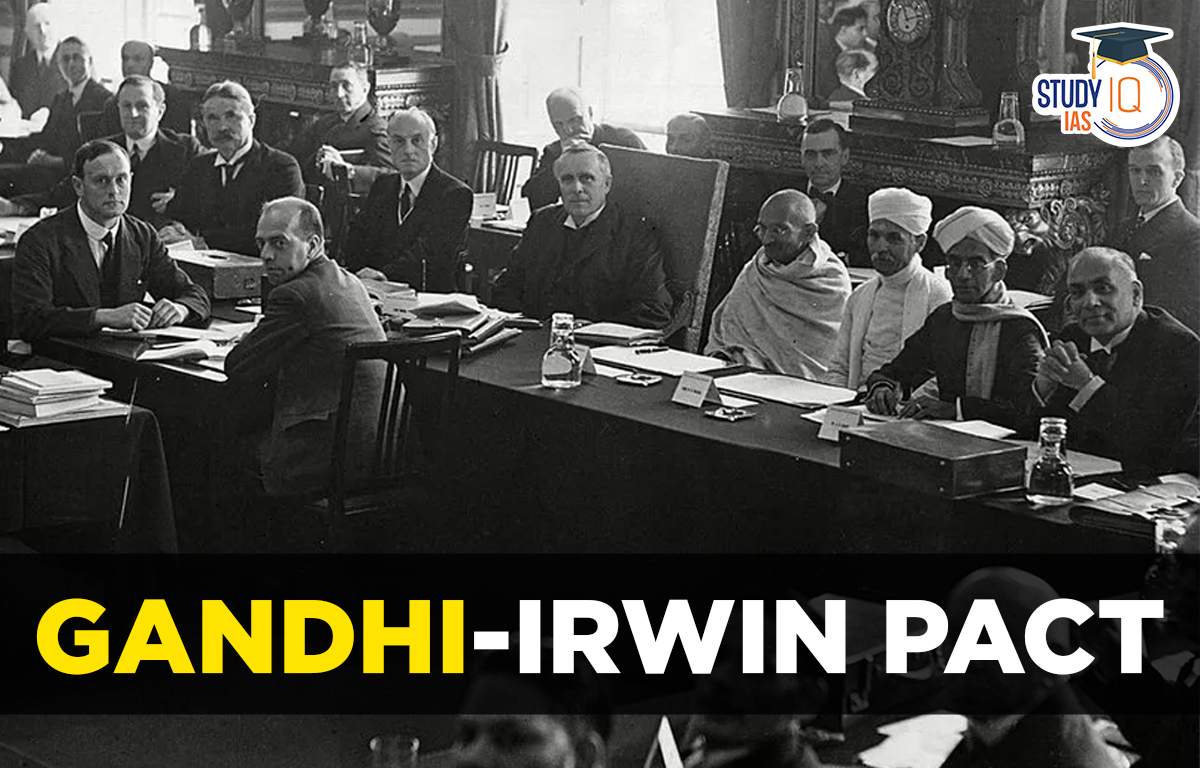Table of Contents
Gandhi-Irwin Pact
The Gandhi-Irwin Pact was signed on March 5, 1931 by Mahatma Gandhi and Lord Irwin, viceroy of India at the time. Just before the start of the second round table conference in London, the agreement was signed. Congress and the government were on equal footing after the Gandhi-Irwin Pact, commonly known as the Delhi Pact.
Mahatma Gandhi and Viceroy Lord Irwin met for a fortnight to discuss plans for the Round Table Conference, which would take place in England. The Gandhi-Irwin Pact was then signed by Gandhi on behalf of the Congress and Lord Irwin on behalf of the British Indian administration. The Gandhi-Irwin Pact will be discussed in this article which will be useful for UPSC exam preparation.
Gandhi-Irwin Pact History
In 1931, the Second Round Table Conference was scheduled to take place in London. The Salt Satyagraha in 1930 brought Gandhi and India to the attention of the world. Indians were subjected to unfair treatment by the British authority in India. Along with thousands of Indians, Gandhi and many other leaders were detained in prison.
Lord Irwin desired a resolution to the situation. Gandhi and all other CWC members were unconditionally released on January 25, 1931, and the CWC gave Gandhi permission to start negotiations with the viceroy. Gandhi was given permission by Congress President Sardar Vallabhai Patel to speak with Lord Irwin.
Gandhi-Irwin Pact Objective
The salt satyagraha helped the world realize India and the terrible features of the British. Lord Irwin was angry and wanted to stop these actions. However, because the first round table conference was unsuccessful, Lord Irwin was able to add INC as a representative.
The Indian National Congress approved the Round Table Conference. The INC would put an end to the campaign of civil disobedience. Rejection of any legislation limiting Congress’s operations. With the exception of cases involving serious offences, all cases are withdrawn. Persons who were detained for taking part in the civil disobedience campaign are released. Another goal was to abolish the salt fee. Accords outlined in the Gandhi-Irwin Pact.
Gandhi-Irwin Pact Features
Gandhi Accepted on Behalf of the Congress
The Round Table Conference was agreed to by the Indian National Congress (INC). The civil disobedience movement would end under the INC.
Irwin on the Behalf of the Government Agreed on
- The immediate release of all political prisoners who have not been found guilty of violence
- Elimination of the salt tax
- Return of all lands that have not yet been sold to third parties; Courteous treatment of resigned government employees; Right to make peaceful and nonviolent pickets; Right to produce salt in coastal towns for personal consumption.
The Viceroy Lord Irwin Rejected the Following Demands Made by Mahatma Gandhi:
- The life sentences for Bhagat Singh, Rajguru, and Sukhdev;
- The call for a public investigation into police abuses during the civil disobedience movement.
Gandhi- Irwin Pact Significance
The Gandhi Irwin Pact is significant in history because it enabled the Indian National Congress to gain the support of millions of Indians and establish itself as a political force. Additionally, it paved the way for the Government of India Act 1935, which expanded India’s diarchy system and permitted Indians to serve as MPs in both houses of the legislature.
Following the 1937 provincial elections, the government was given authority by the elected Indian parliamentarians. On March 5, 1931, Mahatma Gandhi and Lord Irwin, India’s viceroy at the time, signed the Gandhi Irwin Pact.
Gandhi -Irwin Pact Agreements
Mahatma Gandhi provided the British government with a list of 11 requests in 1930 as part of the civil disobedience movement, and he gave it until midnight to approve or deny them. As a result, the Gandhi Irwin Pact was created in 1931. Additionally, the Salt March that was held in India attracted attention on a worldwide scale.
Indians were treated unfairly while under British rule, which aroused criticism. Gandhiji and many other activists were imprisoned. Viceroy Lord Irwin asked for a roundtable session to address the issue.
In January 1931, the Congressmen were allowed to leave custody. Sardar Vallabhbhai Patel, the then-president of the Congress, gave Gandhi permission to talk with the viceroy. After protracted discussions, the two came to an accord known as the Gandhi Irwin Pact. In the Gandhi Irwin Pact, the following requests were made and accepted:
- The administration has agreed to repeal all ordinances.
- In order to spare those who were involved in violence, it decided to release all political detainees.
- It made the decision to permit peaceful protests in front of liquor establishments and multinational clothes retailers.
- It consented to removing the INC restriction.
- It agreed to give the Satyagrahis’ confiscated property back.
- Through the Gandhi Irwin Pact, residents who live near seacoasts were granted permission to collect salt.
- It agreed to waive fines that weren’t yet paid.
- It agreed to treat all government workers kindly when they resigned as a result of the civil disobedience activity.
Gandhi -Irwin Pact Outcome
Members of the CWC attended the second Round Table Conference in September 1931 after skipping the previous conference. All laws outlawing peaceful demonstrations have been repealed. The confiscated property of all Civil Disobedience Movement arrestees who were not charged with acts of violence was returned.
The INC was no longer subject to restrictions, and it was allowed to hold non-violent meetings that had no anti-establishment goals. Native salt produced throughout the Indian Sea beaches was open for trade by common people. The government would allow peaceful demonstrations in front of establishments selling alcohol and other foreign goods.
Irwin, however, resisted the calls for formal investigations into police abuse during the Civil Disobedience Movement and the decision to commute Bhagat Singh’s execution to life in jail.
Gandhi Irwin Pact UPSC
The simplest way to understand Gandhi’s reasoning for making a contract with Viceroy Lord Irwin is to look at his method. It was common to refer to satyagraha campaigns as “struggles,” “rebellions,” and “wars without violence.” However, given their shared connotation, these labels seemed to overemphasize the movements’ unfavorable characteristics, notably opposition and conflict. This article provides comprehensive information about the Gandhi Irwin Pact for the UPSC Examination.
Gandhi Irwin Pact FAQs
Q) What is Gandhian Irwin Pact?
Ans. Before the Second Round Table Conference in London on March 5, 1931, Mahatma Gandhi and Lord Irwin, the Viceroy of India at the time, formed a political pact known as the Gandhi-Irwin Pact.
Q) Why was the Gandhi-Irwin Pact signed?
Ans. Gandhi signed this agreement to free the inmates who weren’t aggressive during the Civil Disobedience Movement, which the British violently put an end to.
Q) What were the Round Table Conferences?
Ans. The Round Table Conferences were three “peace conferences” held by the British government with Indian leaders to talk about India’s independence and constitutional change.
Q) What were Round Table Conferences?
Ans. The Round Table Conferences were three “peace conferences” between British officials and Indian leaders to talk about the country’s independence and constitutional changes.
Q) Which movement is linked to the Gandhi-Irwin Pact?
Ans. The civil disobedience campaign in India was connected to the Gandhi-Irwin Pact. The contract was signed by Lord Irwin and Mahatma Gandhi.


 Desert Climate, Distribution, Climatic C...
Desert Climate, Distribution, Climatic C...
 Deserts of India Map, Features of Thar D...
Deserts of India Map, Features of Thar D...
 Maharashtra’s Mendrachi Vancharai Syst...
Maharashtra’s Mendrachi Vancharai Syst...





















